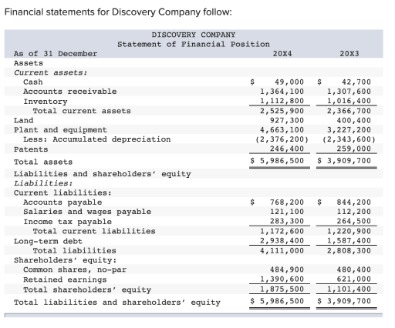
Off-balance sheet items are not inherently intended to be deceptive or misleading, although they can be misused by bad actors to be deceptive. For example, investment management firms are required to keep clients' investments and assets off-balance sheet. For most companies, off-balance sheet items exist in relation to financing, enabling the company to maintain compliance with existing financial covenants. Off-balance sheet items are also used to share the risks and benefits of assets and liabilities with other companies, as in the case of joint venture (JV) projects.
Before this new lease standard, the most common assets to be left off the balance sheet were operating leases, because operating leases of any length were not required to be included. Off-balance sheet (OBS) refers to assets or liabilities that do not appear on a company's balance sheet. Off-balance sheet items, however, are not considered assets or liabilities as they are owned or claimed by an external source, and 5 steps to filing partnership taxes do not affect the financial position of the business. An off-balance sheet (OBS) refers to items such as assets and liabilities that are not included on a company’s balance sheet. A typical tendency in developing accounting rules has been to permit fewer off-balance sheet activities. As a result, those who use financial statements can assess how OBS items have affected or might affect firms' financial status.
Then, they capitalize on every OBS item to achieve their desired comparability. Yet, they could be used to deceive other stakeholders, such as investors or other financial institutions. The stakeholders believe that the firm is financially better off than it is. Accounts receivable (AR) represents a considerable liability for many companies.
Off-Balance Sheet Financing (OBSF) Under the New Accounting Standards
Most importantly, all data is secure.Strengthen the audit process for your European business data companies with our certified GoBD module. Some other examples of off-balance-sheet assets and liabilities can include those that result from joint ventures and other partnerships that involve pooling resources to accomplish a shared task. All reports submitted to the SEC and made available to the public must adhere to Generally Accepted Accounting Principles (GAAP). Furthermore, they have to contain no false statements or omissions of information. All substantial off-balance sheet transactions will be included in reports.
Other examples of off-balance sheet items include guarantees or letters of credit, joint ventures, or research and development activities. Another example of off-balance sheet items would be when investment management firms don’t show the clients’ investments and assets on the balance sheet. This doesn’t mean that leaving these items off of the balance sheet is done for misleading investors or any other deceptive purposes.
- Bonds and loans with total return swaps have all the risk passed to the receiver, allowing the receiver to access the asset immediately in exchange for the risk.
- Similarly to lease vs. buy, the decision on whether to enter into a contract for a finance lease vs. an operating lease will be impacted as well by the removal of the OBS accounting option.
- Although not recorded on the balance sheet, they are still assets and liabilities of the company.
- Get instant access to lessons taught by experienced private equity pros and bulge bracket investment bankers including financial statement modeling, DCF, M&A, LBO, Comps and Excel Modeling.
Although these items do not appear on the balance sheet, they are assets and liabilities of the business. The reason they do not have to report these items on the balance sheet is that there is no equity or debt linked to them. On the other hand, off-balance-sheet items are disclosed separately from the firm's balance sheet. This management tool helps the company mitigate counterparty credit risk and liquidity risk.
Off-Balance-Sheet Financing (OBSF) and Liabilities Impacted by New Operating Lease Accounting Rules
In Enron's case, the company would build an asset such as a power plant and immediately claim the projected profit on its books even though it hadn't made one dime from it. If the revenue from the power plant was less than the projected amount, instead of taking the loss, the company would then transfer these assets to an off-the-books corporation, where the loss would go unreported. The Inter-Company Collector app we developed expands your capabilities for inter-company transactions, especially with regard to critical financial areas. The best solution is the OBS solution - close gaps to accounting-centric ERP software like SAP. The comprehensive features and extensions we have developed, in addition to the Odoo standard, will simplify your processes and allow you to manage factoring with your partner.

Instead of purchasing the machinery, the company may decide to lease it from an external source so that it will not become an asset or liability, and will not need to be recorded on the balance sheet. The use of off-balance sheet items will not affect the reports, and therefore not affect the funding potential for the business. Therefore, when investors examine a company's financial position, they must include all OBS items as on-balance-sheet items. As a result, investors will have a more accurate and unbiased point of view. Activities that do not involve loans and deposits but instead bring in fee income for the banks are called off-balance sheet exposures in the banking industry. Some instances of the banks' OBS exposures include non-fund-based facilities like those we stated above, which are contingent.
Accounting and capital measures of risk: evidence from Asian banks during 1998–2003
For A/R, instead of recording a large and potentially uncollectible asset on their balance sheet some companies opt to sell their A/R asset to another company (called a factor) to pass the risk off to them. The factor company, who now “owns” the asset, pays the original company a percentage of the total value of all A/R upfront and takes care of collecting payments on these high-risk payments from the customers. After the customer pays, the factor remits the balance to the original company, minus a collection fee. In a leaseback agreement, a company sells an asset to another company and then leases it from that other company. This allows the lessee to keep this full asset off the balance sheet and instead only include the right-of-use (ROU) asset and lease liability on the books. Organizations often use this to provide positive cashflow at the time of the sale.
OBS Spring Sale Highlighted by $2.2M Gun Runner Colt - BloodHorse.com
OBS Spring Sale Highlighted by $2.2M Gun Runner Colt.
Posted: Thu, 27 Apr 2023 07:00:00 GMT [source]
For example, collateralized debt obligations (CDO) can become toxic assets, assets that can suddenly become almost completely illiquid, before investors are aware of the company's financial exposure. IFRS 16 and GASB 87 both classify all leases as finance leases, also called a “single-model” approach. This is because the combined interest and depreciation expenses will presumably be higher than the previous rent expense, but they are added back to net income as part of the EBITDA calculation.
An examination of diversification on bank profitability and insolvency risk in 28 financially liberalized markets
This asset category is reserved for funds that have not yet been received from customers, so the possibility of default is high. At the end of the lease term, the lessee generally has the opportunity to purchase the asset at a drastically reduced price. The Enron scandal was one of the first developments to bring the use of off-balance-sheet entities to the public's attention.
The amortization of the right-of-use asset for operating leases and the interest expense portion of the lease payments, are combined as one lease expense. As a result, interest, depreciation, or amortization amounts related to the new operating lease assets and liabilities are not added back into net income when calculating EBITDA. The accounting treatment for a finance lease under ASC 842 will be the same as under ASC 840, so the adoption of ASC 842 will not affect EBITDA unless an organization’s population of finance leases changes due to further analysis. When accounting for a finance lease, whether under ASC 840 or ASC 842, interest on the lease payments is expensed on the organization’s income statement, but the non-interest portion of the lease payments is not expensed.
Footer Legal Links
If during this term, the firm needs to borrow more (to buy certain assets), it may set up a special purpose vehicle (SPV), which by nature entails off-balance sheet accounting. Under previous accounting rules both in the United States (U.S. GAAP) and internationally (IFRS), operating leases were off-balance-sheet financing. Under current accounting rules (ASC 842, IFRS 16), operating leases are on the balance sheet. Financial obligations of unconsolidated subsidiaries (because they are not wholly owned by the parent) may also be off-balance-sheet. Under a leaseback agreement, a company can sell an asset, such as a piece of property, to another entity.

These items are assets and liabilities of the company, even if they don't show up on the balance sheet. Since there is no equity or debt to reflect these items, there is no need to include them on the balance sheet. A business tries to keep certain assets and liabilities off its balance sheet in order to present to the investment community a cleaner balance sheet than would otherwise be the case.
Yet, we have made it our mission to develop additional functions that complement Odoo's existing financial solutions in a meaningful way to significantly optimize several financial processes for our clients. These notes are necessary for investors when they’re analyzing the financial situation of the company. Let’s take a look at a situation where a company may decide to opt for off-balance-sheet financing. Suppose the company wants to buy new equipment but they don’t have the funds to be able to purchase that equipment.
Large asset purchases are often funded with debt financing, but too much debt can make a company less desirable to investors and lenders. Using the off-balance-sheet method for these types of assets can help businesses maintain appealing leverage ratios. Some of the most common OBS assets are operating leases, leaseback agreements, and accounts receivable. Despite OBSF making it difficult for investors and shareholders to compare businesses and their financial statements, off-balance-sheet accounting was standard practice under US GAAP for all operating leases until recently.
